run flat BMW 335I XDRIVE 2009 Owners Manual
[x] Cancel search | Manufacturer: BMW, Model Year: 2009, Model line: 335I XDRIVE, Model: BMW 335I XDRIVE 2009Pages: 268, PDF Size: 11.52 MB
Page 43 of 268
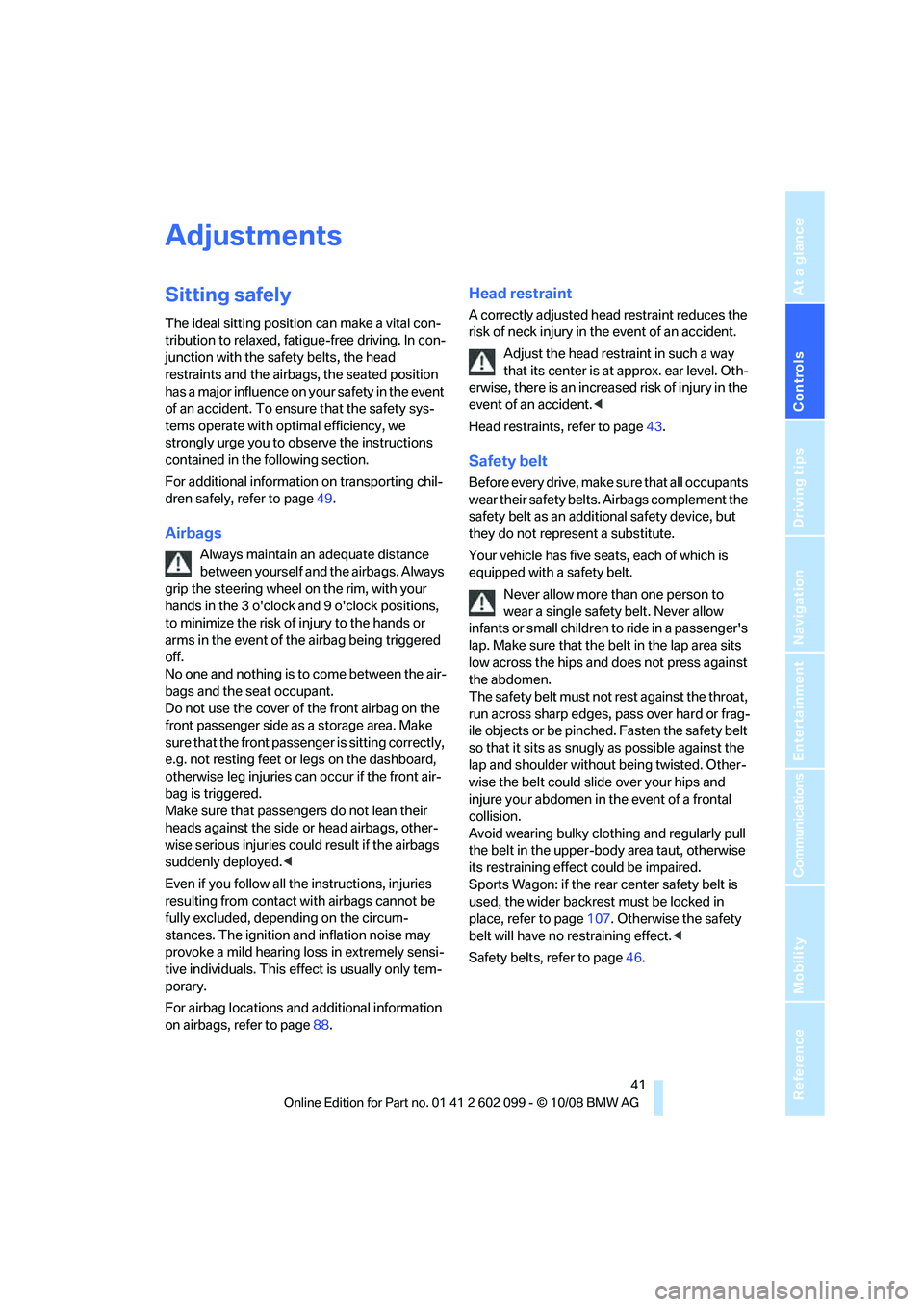
Controls
41Reference
At a glance
Driving tips
Communications
Navigation
Entertainment
Mobility
Adjustments
Sitting safely
The ideal sitting position can make a vital con-
tribution to relaxed, fati gue-free driving. In con-
junction with the safe ty belts, the head
restraints and the airbags, the seated position
has a major influence on your safety in the event
of an accident. To ensu re that the safety sys-
tems operate with optimal efficiency, we
strongly urge you to observe the instructions
contained in the following section.
For additional information on transporting chil-
dren safely, refer to page 49.
Airbags
Always maintain an adequate distance
between yourself and the airbags. Always
grip the steering wheel on the rim, with your
hands in the 3 o'clock and 9 o'clock positions,
to minimize the risk of injury to the hands or
arms in the event of the airbag being triggered
off.
No one and nothing is to come between the air-
bags and the seat occupant.
Do not use the cover of the front airbag on the
front passenger side as a storage area. Make
sure that the front passen ger is sitting correctly,
e.g. not resting feet or legs on the dashboard,
otherwise leg injuries can occur if the front air-
bag is triggered.
Make sure that passengers do not lean their
heads against the side or head airbags, other-
wise serious injuries could result if the airbags
suddenly deployed. <
Even if you follow all the instructions, injuries
resulting from contact with airbags cannot be
fully excluded, depending on the circum-
stances. The ignition and inflation noise may
provoke a mild hearing loss in extremely sensi-
tive individuals. This e ffect is usually only tem-
porary.
For airbag locations and additional information
on airbags, refer to page 88.
Head restraint
A correctly adjusted head restraint reduces the
risk of neck injury in the event of an accident.
Adjust the head restraint in such a way
that its center is at approx. ear level. Oth-
erwise, there is an increased risk of injury in the
event of an accident. <
Head restraints, refer to page 43.
Safety belt
Before every drive, make sure that all occupants
wear their safety belts. Airbags complement the
safety belt as an additi onal safety device, but
they do not represent a substitute.
Your vehicle has five seats, each of which is
equipped with a safety belt.
Never allow more than one person to
wear a single safety belt. Never allow
infants or small children to ride in a passenger's
lap. Make sure that the be lt in the lap area sits
low across the hips and does not press against
the abdomen.
The safety belt must not rest against the throat,
run across sharp edges, pass over hard or frag-
ile objects or be pinched. Fasten the safety belt
so that it sits as snugly as possible against the
lap and shoulder withou t being twisted. Other-
wise the belt could slide over your hips and
injure your abdomen in the event of a frontal
collision.
Avoid wearing bulky clothing and regularly pull
the belt in the upper-bo dy area taut, otherwise
its restraining effect could be impaired.
Sports Wagon: if the rear center safety belt is
used, the wider backrest must be locked in
place, refer to page 107. Otherwise the safety
belt will have no restraining effect. <
Safety belts, refer to page 46.
ba8_E9091_cic.book Seite 41 Mittwoch, 29. Oktober 2008 2:59 14
Page 86 of 268
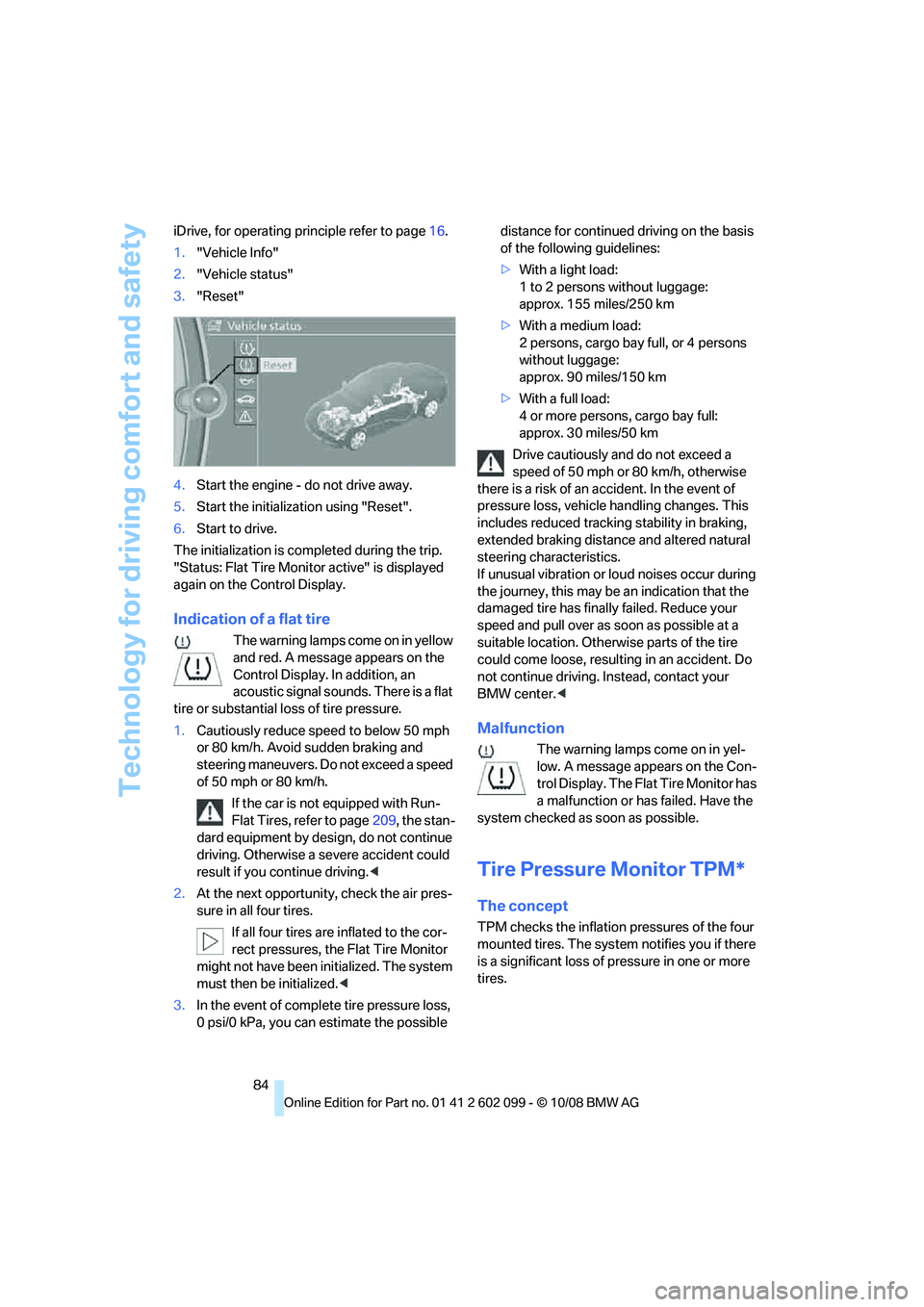
Technology for driving comfort and safety
84
iDrive, for operating pr
inciple refer to page16.
1. "Vehicle Info"
2. "Vehicle status"
3. "Reset"
4. Start the engine - do not drive away.
5. Start the initialization using "Reset".
6. Start to drive.
The initialization is comp leted during the trip.
"Status: Flat Tire Monitor active" is displayed
again on the Control Display.
Indication of a flat tire
The warning lamps come on in yellow
and red. A message appears on the
Control Display. In addition, an
acoustic signal sounds. There is a flat
tire or substantial lo ss of tire pressure.
1. Cautiously reduce sp eed to below 50 mph
or 80 km/h. Avoid sudden braking and
steering maneuvers. Do not exceed a speed
of 50 mph or 80 km/h.
If the car is not equipped with Run-
Flat Tires, refer to page 209, the stan-
dard equipment by design, do not continue
driving. Otherwise a se vere accident could
result if you continue driving. <
2. At the next opportunity, check the air pres-
sure in all four tires.
If all four tires are inflated to the cor-
rect pressures, the Flat Tire Monitor
might not have been initialized. The system
must then be initialized. <
3. In the event of complete tire pressure loss,
0 psi/0 kPa, you can estimate the possible distance for continued driving on the basis
of the following guidelines:
>
With a light load:
1 to 2 persons without luggage:
approx. 155 miles/250 km
> With a medium load:
2 persons, cargo bay full, or 4 persons
without luggage:
approx. 90 miles/150 km
> With a full load:
4 or more persons, cargo bay full:
approx. 30 miles/50 km
Drive cautiously an d do not exceed a
speed of 50 mph or 80 km/h, otherwise
there is a risk of an accident. In the event of
pressure loss, vehicle handling changes. This
includes reduced tracking stability in braking,
extended braking distan ce and altered natural
steering characteristics.
If unusual vibration or lo ud noises occur during
the journey, this may be an indication that the
damaged tire has finally failed. Reduce your
speed and pull over as soon as possible at a
suitable location. Otherw ise parts of the tire
could come loose, resulting in an accident. Do
not continue driving. Instead, contact your
BMW center. <
Malfunction
The warning lamps come on in yel-
low. A message appears on the Con-
trol Display. The Flat Tire Monitor has
a malfunction or has failed. Have the
system checked as soon as possible.
Tire Pressure Monitor TPM*
The concept
TPM checks the inflation pressures of the four
mounted tires. The system notifies you if there
is a significant loss of pressure in one or more
tires.
ba8_E9091_cic.book Seite 84 Mittwoch, 29. Oktober 2008 2:59 14
Page 88 of 268
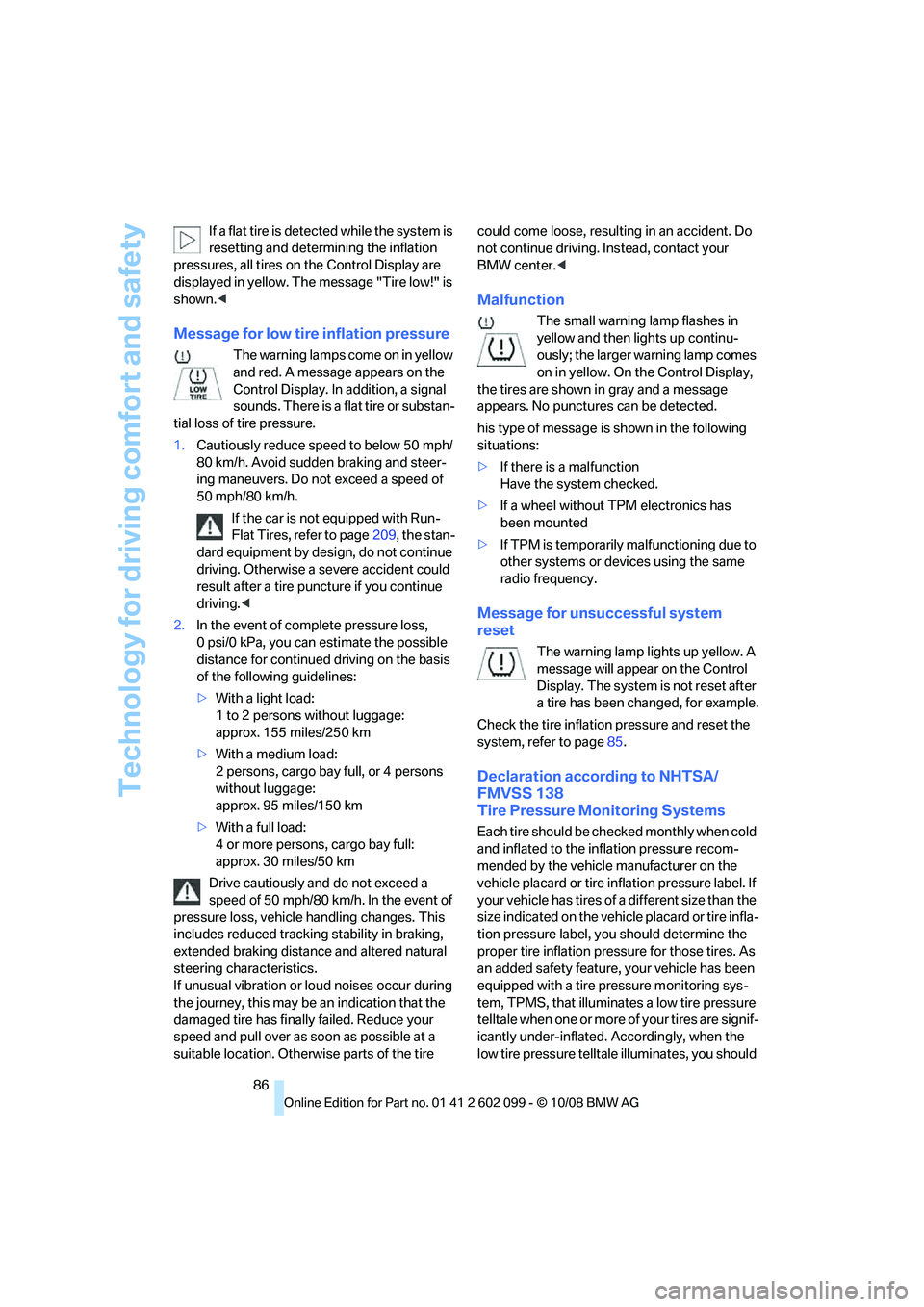
Technology for driving comfort and safety
86
If a flat tire is detect
ed while the system is
resetting and determining the inflation
pressures, all tires on the Control Display are
displayed in yellow. The message "Tire low!" is
shown. <
Message for low tire inflation pressure
The warning lamps come on in yellow
and red. A message appears on the
Control Display. In addition, a signal
sounds. There is a flat tire or substan-
tial loss of tire pressure.
1. Cautiously reduce sp eed to below 50 mph/
80 km/h. Avoid sudden braking and steer-
ing maneuvers. Do not exceed a speed of
50 mph/80 km/h.
If the car is not equipped with Run-
Flat Tires, refer to page 209, the stan-
dard equipment by design, do not continue
driving. Otherwise a se vere accident could
result after a tire punc ture if you continue
driving. <
2. In the event of complete pressure loss,
0 psi/0 kPa, you can estimate the possible
distance for continued driving on the basis
of the following guidelines:
>With a light load:
1 to 2 persons without luggage:
approx. 155 miles/250 km
> With a medium load:
2 persons, cargo bay full, or 4 persons
without luggage:
approx. 95 miles/150 km
> With a full load:
4 or more persons, cargo bay full:
approx. 30 miles/50 km
Drive cautiously and do not exceed a
speed of 50 mph/80 km/h. In the event of
pressure loss, vehicle handling changes. This
includes reduced tracking stability in braking,
extended braking distance and altered natural
steering characteristics.
If unusual vibration or lo ud noises occur during
the journey, this may be an indication that the
damaged tire has finally failed. Reduce your
speed and pull over as soon as possible at a
suitable location. Otherw ise parts of the tire could come loose, resulting in an accident. Do
not continue driving. Instead, contact your
BMW center.
<
Malfunction
The small warning lamp flashes in
yellow and then lights up continu-
ously; the larger warning lamp comes
on in yellow. On the Control Display,
the tires are shown in gray and a message
appears. No punctures can be detected.
his type of message is shown in the following
situations:
> If there is a malfunction
Have the system checked.
> If a wheel without TPM electronics has
been mounted
> If TPM is temporarily malfunctioning due to
other systems or devices using the same
radio frequency.
Message for unsuccessful system
reset
The warning lamp lights up yellow. A
message will appear on the Control
Display. The system is not reset after
a tire has been changed, for example.
Check the tire inflation pressure and reset the
system, refer to page 85.
Declaration according to NHTSA/
FMVSS 138
Tire Pressure Monitoring Systems
Each tire should be checked monthly when cold
and inflated to the inflation pressure recom-
mended by the vehicle manufacturer on the
vehicle placard or tire infl ation pressure label. If
your vehicle has tires of a different size than the
size indicated on the vehicle placard or tire infla-
tion pressure label, yo u should determine the
proper tire inflation pressure for those tires. As
an added safety feature, your vehicle has been
equipped with a tire pressure monitoring sys-
tem, TPMS, that illuminates a low tire pressure
telltale when one or more of your tires are signif-
icantly under-inflated. Accordingly, when the
low tire pressure telltale illuminates, you should
ba8_E9091_cic.book Seite 86 Mittwoch, 29. Oktober 2008 2:59 14
Page 197 of 268
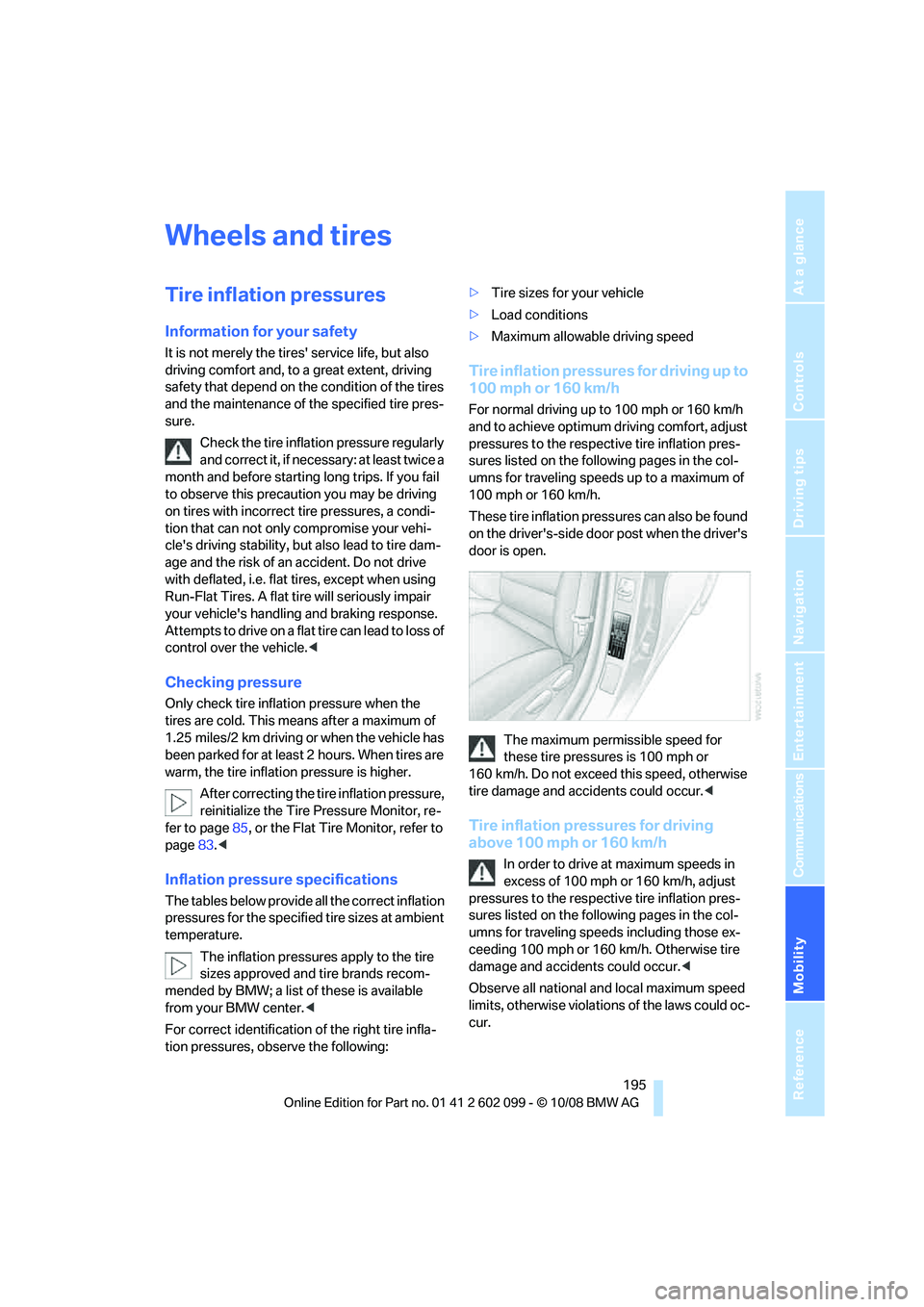
Mobility
195Reference
At a glance
Controls
Driving tips
Communications
Navigation
Entertainment
Wheels and tires
Tire inflation pressures
Information for your safety
It is not merely the tires' service life, but also
driving comfort and, to a great extent, driving
safety that depend on th e condition of the tires
and the maintenance of the specified tire pres-
sure.
Check the tire inflation pressure regularly
and correct it, if nece ssary: at least twice a
month and before starting long trips. If you fail
to observe this precauti on you may be driving
on tires with incorrect tire pressures, a condi-
tion that can not only compromise your vehi-
cle's driving stability, but also lead to tire dam-
age and the risk of an accident. Do not drive
with deflated, i.e. flat tires, except when using
Run-Flat Tires. A flat tire will seriously impair
your vehicle's handling and braking response.
Attempts to drive on a flat tire can lead to loss of
control over the vehicle. <
Checking pressure
Only check tire inflation pressure when the
tires are cold. This means after a maximum of
1.25 miles/2 km driving or when the vehicle has
been parked for at least 2 hours. When tires are
warm, the tire inflation pressure is higher.
After correcting the tire inflation pressure,
reinitialize the Tire Pressure Monitor, re-
fer to page 85, or the Flat Tire Monitor, refer to
page 83.<
Inflation pressure specifications
The tables below provide all the correct inflation
pressures for the specified tire sizes at ambient
temperature.
The inflation pressures apply to the tire
sizes approved and tire brands recom-
mended by BMW; a list of these is available
from your BMW center. <
For correct identification of the right tire infla-
tion pressures, observe the following: >
Tire sizes for your vehicle
> Load conditions
> Maximum allowable driving speed
Tire inflation pressures for driving up to
100 mph or 160 km/h
For normal driving up to 100 mph or 160 km/h
and to achieve optimum driving comfort, adjust
pressures to the respecti ve tire inflation pres-
sures listed on the follo wing pages in the col-
umns for traveling speeds up to a maximum of
100 mph or 160 km/h.
These tire inflation pres sures can also be found
on the driver's-side door post when the driver's
door is open.
The maximum permissible speed for
these tire pressures is 100 mph or
160 km/h. Do not exceed this speed, otherwise
tire damage and accidents could occur. <
Tire inflation pressures for driving
above 100 mph or 160 km/h
In order to drive at maximum speeds in
excess of 100 mph or 160 km/h, adjust
pressures to the respecti ve tire inflation pres-
sures listed on the follo wing pages in the col-
umns for traveling speeds including those ex-
ceeding 100 mph or 160 km/h. Otherwise tire
damage and accidents could occur. <
Observe all national an d local maximum speed
limits, otherwise violations of the laws could oc-
cur.
ba8_E9091_cic.book Seite 195 Mittwoch, 29. Oktober 2008 2:59 14
Page 210 of 268
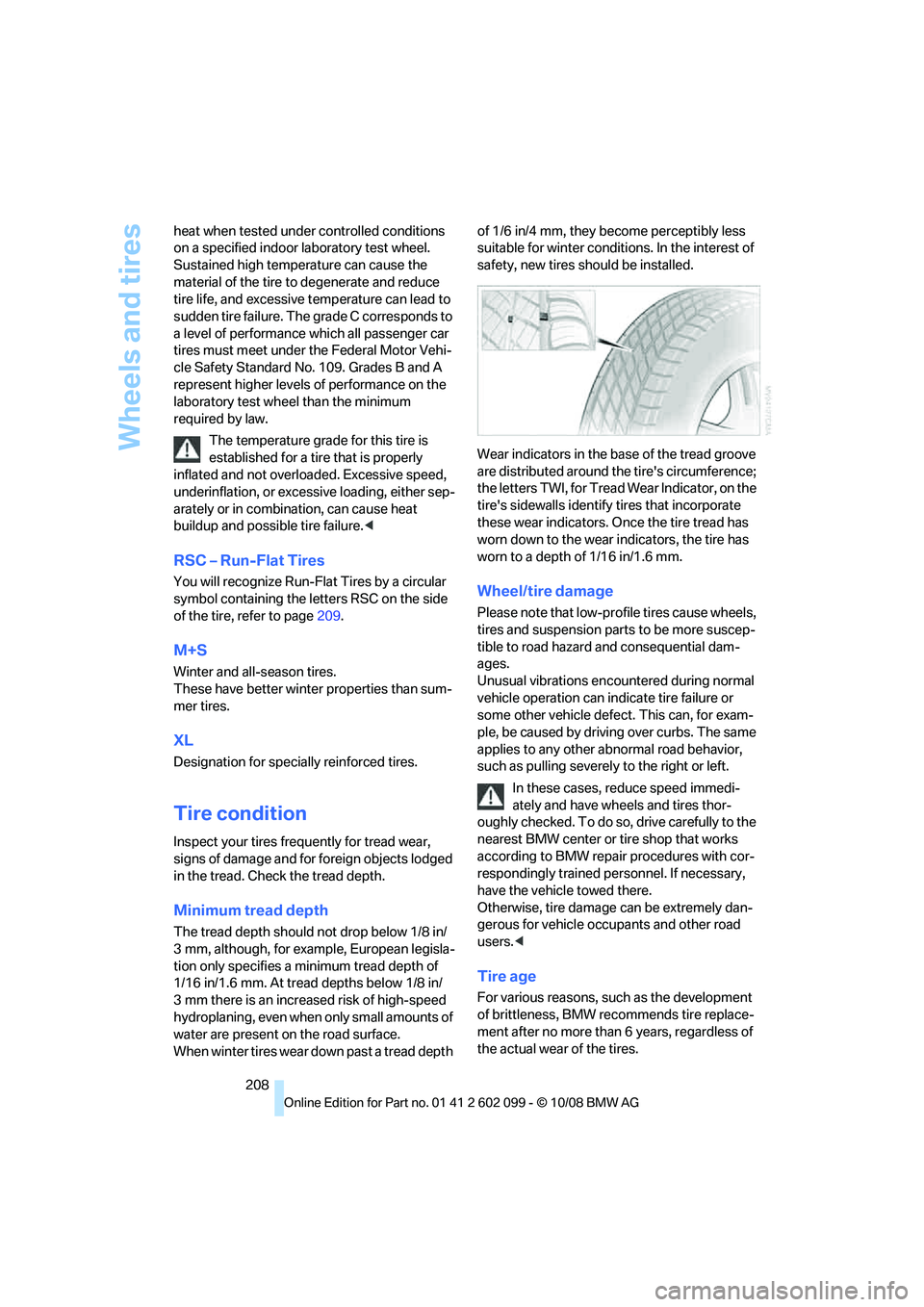
Wheels and tires
208
heat when tested under controlled conditions
on a specified indoor laboratory test wheel.
Sustained high temperature can cause the
material of the tire to
degenerate and reduce
tire life, and excessive temperature can lead to
sudden tire failure. The grade C corresponds to
a level of performance which all passenger car
tires must meet under the Federal Motor Vehi-
cle Safety Standard No. 109. Grades B and A
represent higher levels of performance on the
laboratory test whee l than the minimum
required by law.
The temperature grade for this tire is
established for a tire that is properly
inflated and not overloaded. Excessive speed,
underinflation, or excessi ve loading, either sep-
arately or in combination, can cause heat
buildup and possible tire failure. <
RSC – Run-Flat Tires
You will recognize Run-Flat Tires by a circular
symbol containing the letters RSC on the side
of the tire, refer to page209.
M+S
Winter and all-season tires.
These have better winter properties than sum-
mer tires.
XL
Designation for specia lly reinforced tires.
Tire condition
Inspect your tires frequently for tread wear,
signs of damage and for foreign objects lodged
in the tread. Check the tread depth.
Minimum tread depth
The tread depth should not drop below 1/8 in/
3mm, although, for exam ple, European legisla-
tion only specifies a minimum tread depth of
1/16 in/1.6 mm. At tread depths below 1/8 in/
3 mm there is an increased risk of high-speed
hydroplaning, even when only small amounts of
water are present on the road surface.
When winter tires wear down past a tread depth of 1/6 in/4 mm, they become perceptibly less
suitable for winter conditions. In the interest of
safety, new tires sh
ould be installed.
Wear indicators in the ba se of the tread groove
are distributed around th e tire's circumference;
the letters TWI, for Tread Wear Indicator, on the
tire's sidewalls identify tires that incorporate
these wear indicators. On ce the tire tread has
worn down to the wear indicators, the tire has
worn to a depth of 1/16 in/1.6 mm.
Wheel/tire damage
Please note that low-pr ofile tires cause wheels,
tires and suspension parts to be more suscep-
tible to road hazard and consequential dam-
ages.
Unusual vibrations encountered during normal
vehicle operation can indi cate tire failure or
some other vehicle defect. This can, for exam-
ple, be caused by driving over curbs. The same
applies to any other abnormal road behavior,
such as pulling severely to the right or left.
In these cases, reduce speed immedi-
ately and have wheels and tires thor-
oughly checked. To do so, drive carefully to the
nearest BMW center or tire shop that works
according to BMW repair procedures with cor-
respondingly trained personnel. If necessary,
have the vehicle towed there.
Otherwise, tire damage can be extremely dan-
gerous for vehicle occu pants and other road
users. <
Tire age
For various reasons, such as the development
of brittleness, BMW re commends tire replace-
ment after no more than 6 years, regardless of
the actual wear of the tires.
ba8_E9091_cic.book Seite 208 Mittwoch, 29. Oktober 2008 2:59 14
Page 211 of 268
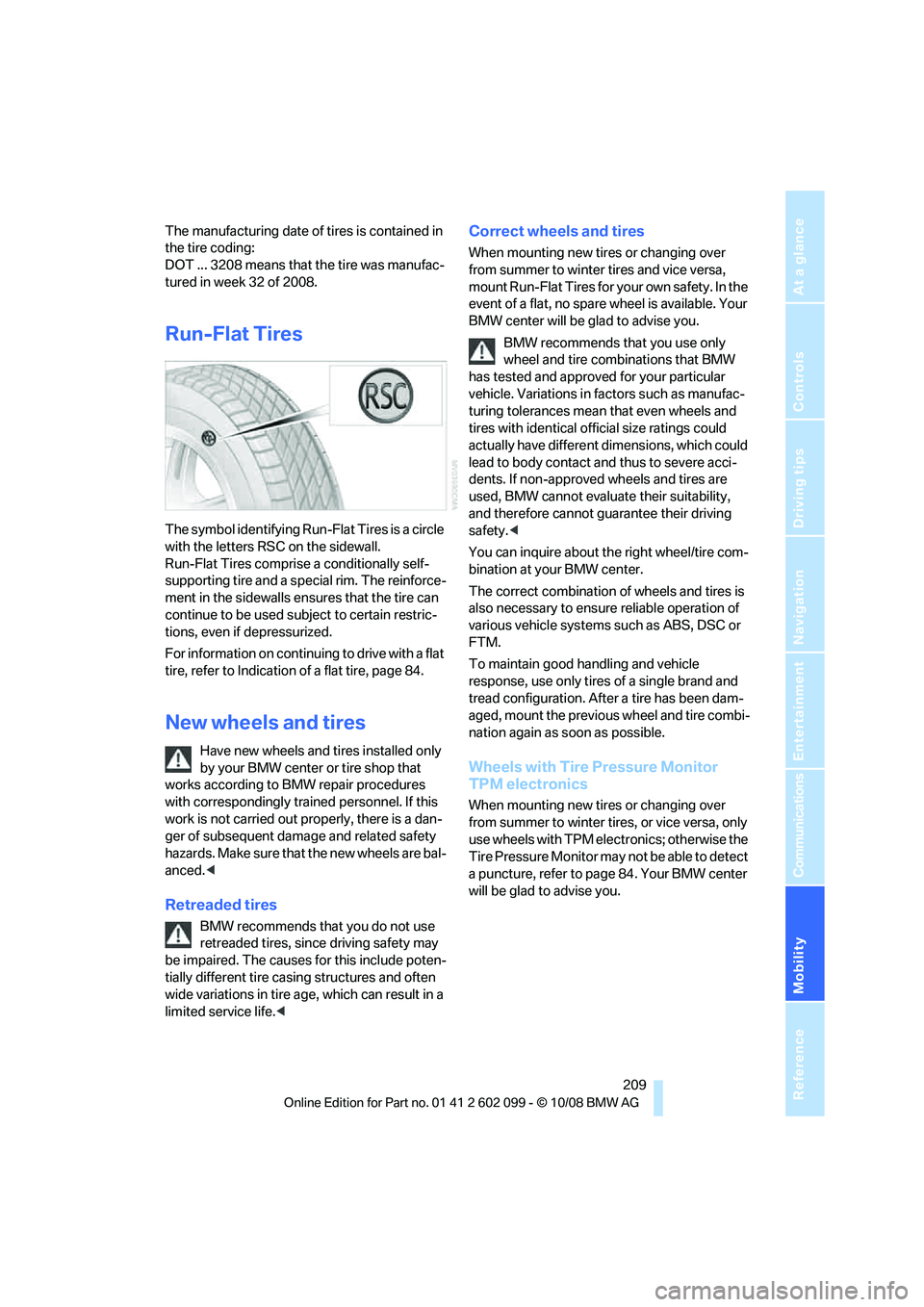
Mobility
209Reference
At a glance
Controls
Driving tips
Communications
Navigation
Entertainment
The manufacturing date of tires is contained in
the tire coding:
DOT ... 3208 means that the tire was manufac-
tured in week 32 of 2008.
Run-Flat Tires
The symbol identifying Run-Flat Tires is a circle
with the letters RSC on the sidewall.
Run-Flat Tires comprise a conditionally self-
supporting tire and a special rim. The reinforce-
ment in the sidewalls ensures that the tire can
continue to be used su bject to certain restric-
tions, even if depressurized.
For information on continuing to drive with a flat
tire, refer to Indication of a flat tire, page 84.
New wheels and tires
Have new wheels and tires installed only
by your BMW center or tire shop that
works according to BMW repair procedures
with correspondingly trai ned personnel. If this
work is not carried out properly, there is a dan-
ger of subsequent dama ge and related safety
hazards. Make sure that the new wheels are bal-
anced. <
Retreaded tires
BMW recommends that you do not use
retreaded tires, since driving safety may
be impaired. The causes for this include poten-
tially different tire casing structures and often
wide variations in tire ag e, which can result in a
limited service life. <
Correct wheels and tires
When mounting new tires or changing over
from summer to winter tires and vice versa,
mount Run-Flat Tires for your own safety. In the
event of a flat, no spare wheel is available. Your
BMW center will be glad to advise you.
BMW recommends that you use only
wheel and tire combinations that BMW
has tested and approved for your particular
vehicle. Variations in factors such as manufac-
turing tolerances mean that even wheels and
tires with identical official size ratings could
actually have different dimensions, which could
lead to body contact and thus to severe acci-
dents. If non-approved wheels and tires are
used, BMW cannot evaluate their suitability,
and therefore cannot guarantee their driving
safety. <
You can inquire about the right wheel/tire com-
bination at your BMW center.
The correct combination of wheels and tires is
also necessary to ensure reliable operation of
various vehicle systems such as ABS, DSC or
FTM.
To maintain good handling and vehicle
response, use only tires of a single brand and
tread configuration. After a tire has been dam-
aged, mount the previous wheel and tire combi-
nation again as soon as possible.
Wheels with Tire Pressure Monitor
TPM electronics
When mounting new tires or changing over
from summer to winter tires, or vice versa, only
use wheels with TPM electronics; otherwise the
Tire Pressure Monitor may not be able to detect
a puncture, refer to page 84. Your BMW center
will be glad to advise you.
ba8_E9091_cic.book Seite 209 Mittwoch, 29. Oktober 2008 2:59 14
Page 230 of 268
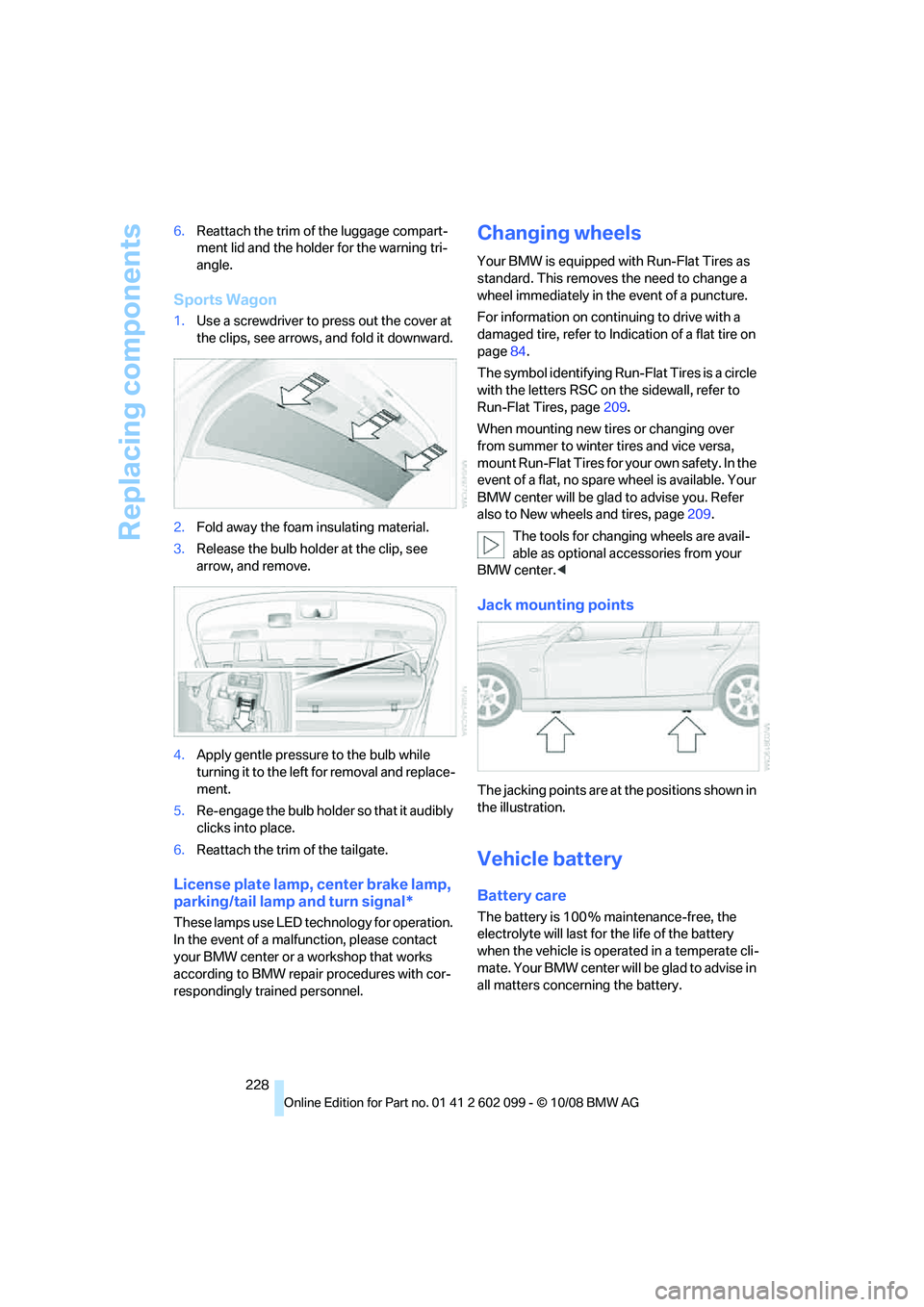
Replacing components
228
6.
Reattach the trim of the luggage compart-
ment lid and the holder for the warning tri-
angle.
Sports Wagon
1. Use a screwdriver to press out the cover at
the clips, see arrows, and fold it downward.
2. Fold away the foam insulating material.
3. Release the bulb holder at the clip, see
arrow, and remove.
4. Apply gentle pressure to the bulb while
turning it to the left for removal and replace-
ment.
5. Re-engage the bulb holder so that it audibly
clicks into place.
6. Reattach the trim of the tailgate.
License plate lamp, center brake lamp,
parking/tail lamp and turn signal*
These lamps use LED technology for operation.
In the event of a malfunction, please contact
your BMW center or a workshop that works
according to BMW repair procedures with cor-
respondingly trained personnel.
Changing wheels
Your BMW is equipped with Run-Flat Tires as
standard. This removes the need to change a
wheel immediately in the event of a puncture.
For information on continuing to drive with a
damaged tire, refer to Indica tion of a flat tire on
page 84.
The symbol identifying Run- Flat Tires is a circle
with the letters RSC on the sidewall, refer to
Run-Flat Tires, page 209.
When mounting new tires or changing over
from summer to winter tires and vice versa,
mount Run-Flat Tires for your own safety. In the
event of a flat, no spare wheel is available. Your
BMW center will be glad to advise you. Refer
also to New wheels and tires, page 209.
The tools for changing wheels are avail-
able as optional accessories from your
BMW center. <
Jack mounting points
The jacking points are at the positions shown in
the illustration.
Vehicle battery
Battery care
The battery is 100 % ma intenance-free, the
electrolyte will last for the life of the battery
when the vehicle is operated in a temperate cli-
mate. Your BMW center will be glad to advise in
all matters concerning the battery.
ba8_E9091_cic.book Seite 228 Mittwoch, 29. Oktober 2008 2:59 14
Page 233 of 268
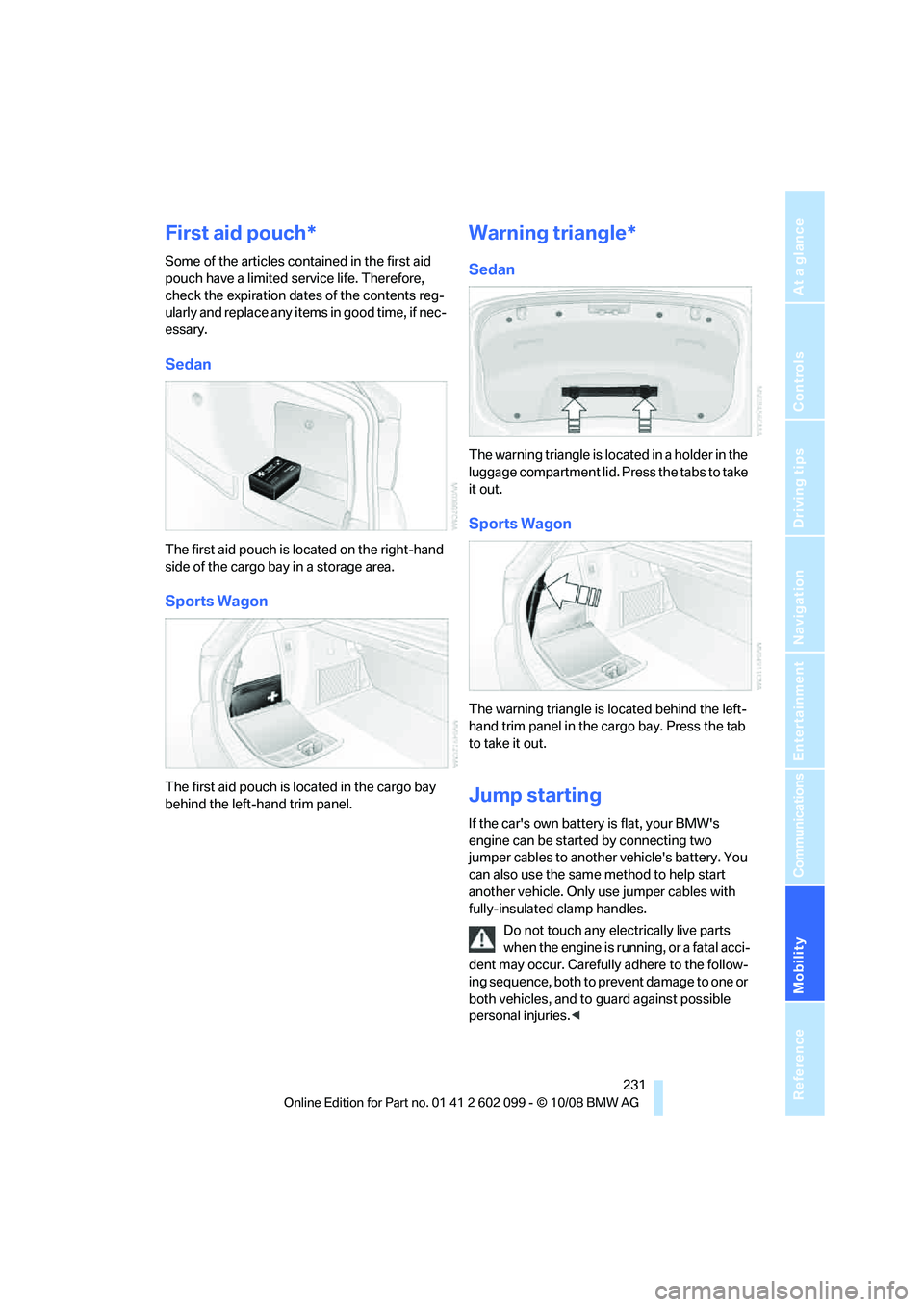
Mobility
231Reference
At a glance
Controls
Driving tips
Communications
Navigation
Entertainment
First aid pouch*
Some of the articles contained in the first aid
pouch have a limited service life. Therefore,
check the expiration dates of the contents reg-
ularly and replace any items in good time, if nec-
essary.
Sedan
The first aid pouch is located on the right-hand
side of the cargo bay in a storage area.
Sports Wagon
The first aid pouch is located in the cargo bay
behind the left-hand trim panel.
Warning triangle*
Sedan
The warning triangle is lo cated in a holder in the
luggage compartment lid. Pr ess the tabs to take
it out.
Sports Wagon
The warning triangle is located behind the left-
hand trim panel in the cargo bay. Press the tab
to take it out.
Jump starting
If the car's own battery is flat, your BMW's
engine can be started by connecting two
jumper cables to anothe r vehicle's battery. You
can also use the same method to help start
another vehicle. Only use jumper cables with
fully-insulated clamp handles.
Do not touch any electrically live parts
when the engine is running, or a fatal acci-
dent may occur. Carefully adhere to the follow-
ing sequence, both to pr event damage to one or
both vehicles, and to guard against possible
personal injuries. <
ba8_E9091_cic.book Seite 231 Mittwoch, 29. Oktober 2008 2:59 14
Page 257 of 268

Reference 255
At a glance
Controls
Driving tips
Communications
Navigation
Entertainment
Mobility
Environmentally friendly driving, refer to Energy
Control 68
Equalizer, tone setting 143
Error messages, refer to
Check Control 75
Event data recorders 217
Exhaust system, refer to Hot
exhaust system 115
Expanding the cargo bay 107
Exterior mirrors 47
– adjusting 47
– automatic dimming
feature 48
– automatic heating 47
– folding in and out 47
External audio device 103
Eyes
– for tow-starting and towing
away 233
– for tying down loads 118
F
Failure messages, refer to
Check Control 75
Failure of an electrical consumer 229
False alarm
– avoiding unintentional alarm 34
– switching off an alarm 33
Fastening safety belts, refer to Safety belts 46
Fastest route for navigation 133
Fast forward
– CD changer 152
– CD player 152
Filter
– refer to Microfilter/activated- charcoal filter for automatic
climate control 97
First aid pouch 231
Fixture for remote control, refer to Ignition lock 53
Flash when locking/ unlocking 28 Flat tire
– Run-Flat Tires
209
– Tire Pressure Monitor TPM 84
Flat Tire Monitor FTM 83
– indicating a flat tire 84
– indicator/warning lamp 84
– initializing the system 83
– malfunction 84
– snow chains 83,210
– system limits 83
Flat tires, refer to Tire condition 208
Fluid reservoir, refer to Washer fluid reservoir 59
FM, waveband 145
Fog lamps 92
– indicator lamp 13,92
Folding rear seat backrest 107
Folding up the floor panel 109
Footbrake, refer to Braking safely 116
Footwell lamps, refer to Interior lamps 93
For your own safety 5
Four-wheel drive, refer to xDrive 82
Free memory capacity, music
collection 159
Front airbags 88
FTM, refer to Flat Tire
Monitor 83
Fuel 191
– additives 192
– average consumption 69
– gauge 68
– high-qu
ality brands 191
– quality 191
– specifications 191
– tank contents, refer to
Capacities 242
Fuel clock, refer to Fuel gauge 68
Fuel display, refer to Fuel gauge 68
Fuel-efficient driving, refer to
Energy Control 68 Fuel filler door
190
– releasing in the event of
electrical malfunction 190
Fuses 229
G
Garage door opener, refer to
Integrated universal remote
control 99
Gasoline
– refer to Average consumption 69
Gasoline, refer to Required
fuel 191
Gasoline display, refer to Fuel
gauge 68
Gear indicator, automatic transmission with
Steptronic 55
Gearshift lever
– automatic transmission with
Steptronic 56
– manual transmission 55
Gearshifts
– automatic transmission with Steptronic 56
– manual transmission 55
General driving notes 115
Glass roof, electric 37
– closing after electrical
malfunction 37
– convenient operation 28,29
– initializing 37
– opening, closing 37
– pinch protection system 37
– power failure 37
– raising 37
– remote control 28
Glove compartment 102
GPS navigation, refer to Navigation system 122
Grills 94
Gross vehicle weight, refer to Weights 241
ba8_E9091_cic.book Seite 255 Mittwoch, 29. Oktober 2008 2:59 14
Page 258 of 268
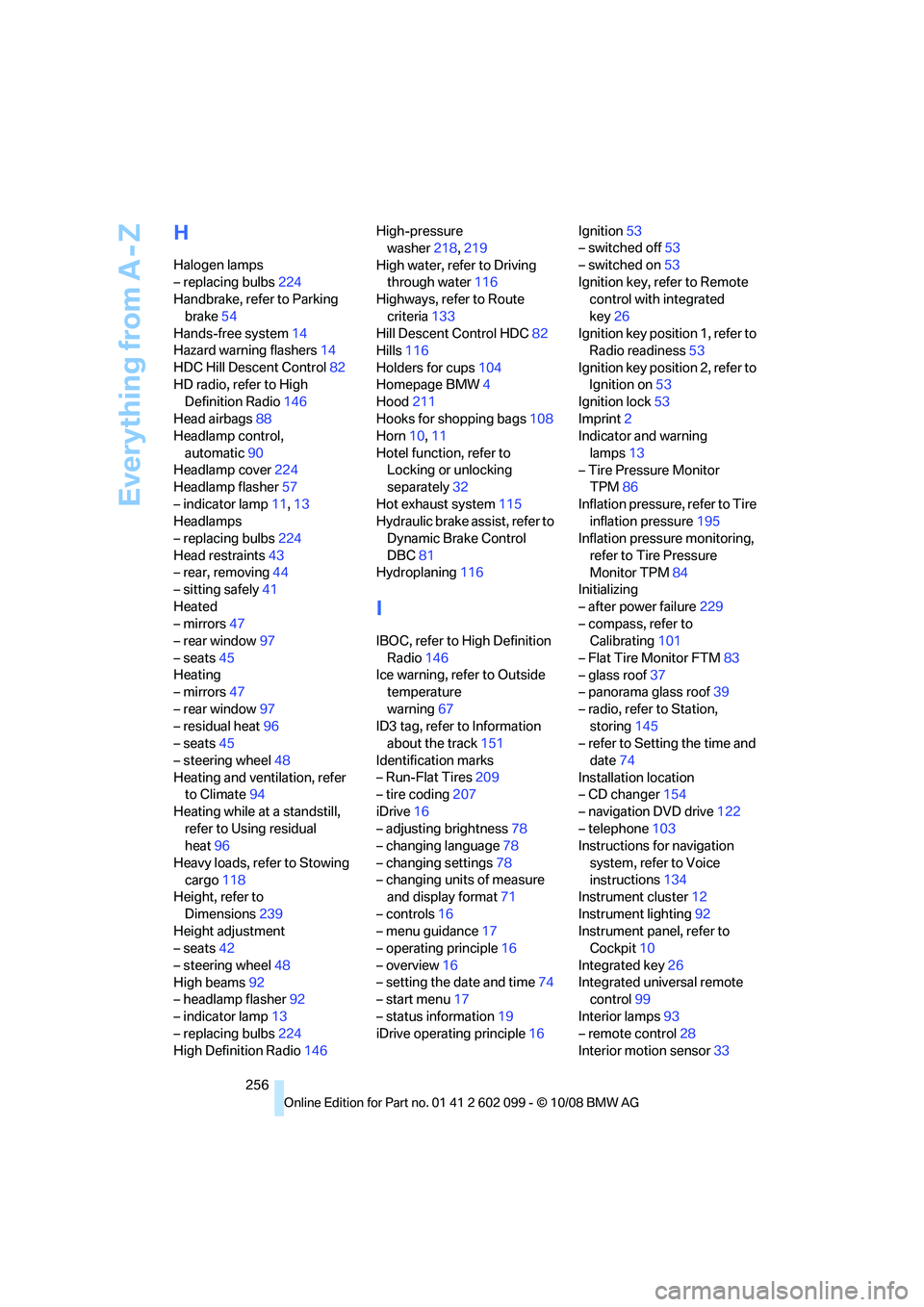
Everything from A - Z
256
H
Halogen lamps
– replacing bulbs224
Handbrake, refer to Parking
brake 54
Hands-free system 14
Hazard warning flashers 14
HDC Hill Descent Control 82
HD radio, refer to High Definition Radio 146
Head airbags 88
Headlamp control,
automatic 90
Headlamp cover 224
Headlamp flasher 57
– indicator lamp 11,13
Headlamps
– replacing bulbs 224
Head restraints 43
– rear, removing 44
– sitting safely 41
Heated
– mirrors 47
– rear window 97
– seats 45
Heating
– mirrors 47
– rear window 97
– residual heat 96
– seats 45
– steering wheel 48
Heating and ventilation, refer to Climate 94
Heating while at a standstill, refer to Using residual
heat 96
Heavy loads, refer to Stowing cargo 118
Height, refer to
Dimensions 239
Height adjustment
– seats 42
– steering wheel 48
High beams 92
– headlamp flasher 92
– indicator lamp 13
– replacing bulbs 224
High Definition Radio 146High-pressure
washer 218,219
High water, refer to Driving through water 116
Highways, refer to Route
criteria 133
Hill Descent Control HDC 82
Hills 116
Holders for cups 104
Homepage BMW 4
Hood 211
Hooks for shopping bags 108
Ho
rn 10, 11
Hotel function, refer to Locking or unlocking
separately 32
Hot exhaust system 115
Hydraulic brake assist, refer to Dynamic Brake Control
DBC 81
Hydroplaning 116
I
IBOC, refer to High Definition
Radio 146
Ice warning, refer to Outside temperature
warning 67
ID3 tag, refer to Information about the track 151
Identification marks
– Run-Flat Tires 209
– tire coding 207
iDrive 16
– adjusting brightness 78
– changing language 78
– changing settings 78
– changing units of measure and display format 71
– controls 16
– menu guidance 17
– operating principle 16
– overview 16
– setting the date and time 74
– start menu 17
– status information 19
iDrive operating principle 16Ignition
53
– switched off 53
– switched on 53
Ignition key, refer to Remote control with integrated
key 26
Ignition key position 1, refer to Radio readiness 53
Ignition key position 2, refer to Ignition on 53
Ignition lock 53
Imprint 2
Indicator and warning
lamps 13
– Tire Pressure Monitor TPM 86
Inflation pressure, refer to Tire inflation pressure 195
Inflation pressure monitoring,
refer to Tire Pressure
Monitor TPM 84
Initializing
– after power failure 229
– compass, refer to Calibrating 101
– Flat Tire Monitor FTM 83
– glass roof 37
– panorama glass roof 39
– radio, refer to Station, storing 145
– refer to Setting the time and
date 74
Installation location
– CD changer 154
– navigation DVD drive 122
– telephone 103
Instructions for navigation
system, refer to Voice
instr
uctions 134
Instrument cluster 12
Instrument lighting 92
Instrument panel, refer to Cockpit 10
Integrated key 26
Integrated universal remote control 99
Interior lamps 93
– remote control 28
Interior motion sensor 33
ba8_E9091_cic.book Seite 256 Mittwoch, 29. Oktober 2008 2:59 14